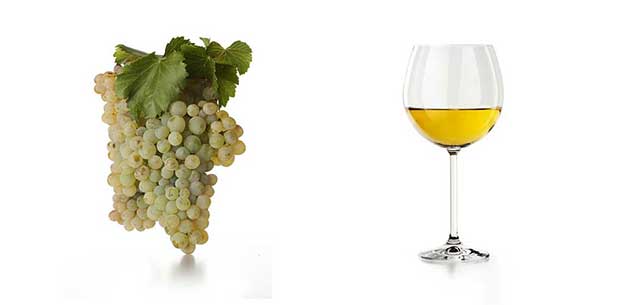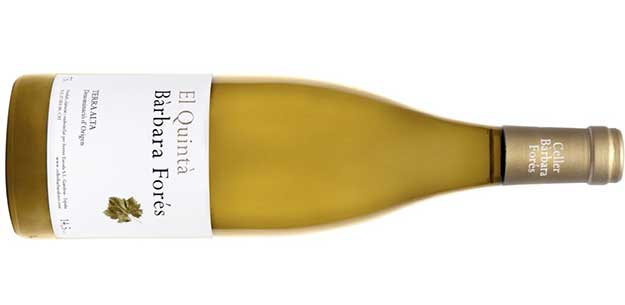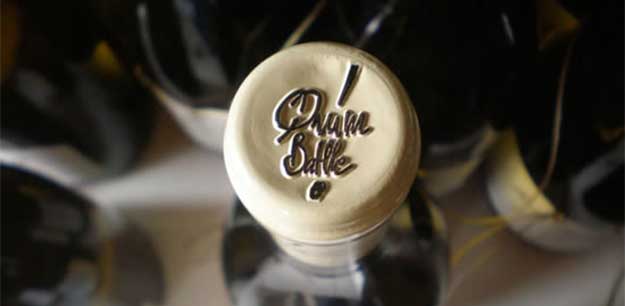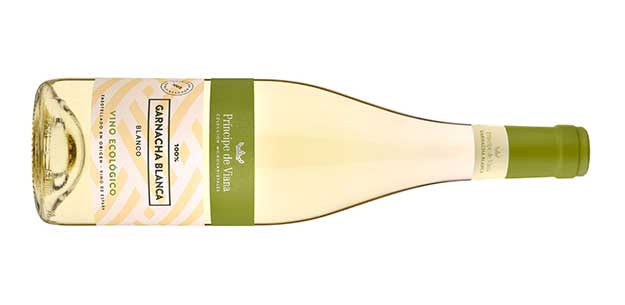.png.transform/rendition-xs/image_image%20(1).png)
Garnacha Blanca Goes Solo at Last!
White grape variety Garnacha Blanca may have nothing on its better known and more abundant red counterpart Garnacha tinta, but in recent years this Spanish grape has been carving out a niche for itself by way of uniquely exquisite single-variety wines, while also continuing to play a supporting role in blends from regions like Catalonia, Aragón, Rioja and Navarre.
Text: Adrienne Smith/@ICEX.

I still remember the very first 100% white Garnacha wine I ever tried. It was from DOCa Priorat (although the name of the winery escapes me) and as it slid silkily over my tongue like honeyed velvet, I was struck by its lemony and mineral palate – in fact, I'm not sure I had ever truly grasped the meaning of a mineral wine before that moment – reminiscent of rain drops falling on white slate. Since then, I have been drawn to this grape, whose unctuous body; floral, citrus and mineral aromas; and great capacity for aging, is yielding a small, but growing selection of interesting single-variety wines in northeastern Spain, which are decidedly Mediterranean in style and brimming with personality.
Likel the result of a mutation of the world-famous and extremely prolific red Garnacha variety, which can be traced back more than 500 years to the heart of Aragón, Garnacha Blanca is planted primarily in Catalonia, followed by Aragón, Rioja and Navarre. This hearty vine with its medium-sized clusters adapts well to warm and relatively dry climates, but its moderate acidity level gets a welcome boost in cooler areas of northern Spain, and particularly in regions like Designations of Origin Terra Alta, Alella, Costers del Segre, Tarragona and DOCa Priorat in Catalonia – where it is called Garnaxa Blanca – as well as in Cariñena, Calatayud and Somontano in Aragón. Other names for this grape include Alicante Blanca, Garnacha Gris, Garnacho Blanco (in Rioja), Vernatxa Blanca, Lladoner Blanco, Lledoné, Silla Blanc, Sillina Blank and of course the French Grenache Blanc.
Silky gold
In general, Garnacha Blanca produces golden-hued, full-bodied wines with a generous alcohol content, which lends them a soft and unctuous palate. Its aromas include floral and citrus, as well as notes of ripe stone fruit like apricots – at times with hints of dill, broom, thyme, rosemary and other scrub/herbs/undergrowth???. It is often blended with grapes like Macabeo, Parellada and Moscatel to make dry or sometimes sparkling wines, and even with Pedro Ximénez to make mistela. Furthermore, one of the attractions of this grape in terms of single-variety wines is how wonderfully it stands up to barrel aging, and/or contact with its lees, both of which enhance the complexity of its aromas and its velvety texture.
More than thirty years ago, cultivation of this native Spanish grape reached more than 16,000 hectares, according to statistics from the Spanish Ministry of Agriculture, Food, Fisheries and the Environment. By 2007, however, the total surface area of Garnacha Blanca vines in Spain was just 2,100 hectares, slightly more than there are today. However, it's also safe to say that this grape is making a comeback, as consumers seek out new styles of wines and relish in the discovery of lesser known wine regions.
The essence of Terra Alta

Nowhere is this more true than in the Catalonian DO Terra Alta, which boasts 1,400 hectares of Garnacha Blanca vines, with an average age of a quarter-century. According to the region’s Regulatory Board, these represent 90% of all white Garnacha grown in Catalonia, 75% of those grown in Spain and nearly a third of vines worldwide. Located in the province of Tarragona in southern Catalonia, between the Ebro River and the border with Aragón, the single-variety Garnacha Blanca wines made here are characterized by complex aromas of citrus, peach and lemon; chalky minerality and a creamy texture, as well as an intense and lasting palate.
One Terra Alta winery that has been making waves in recent years with its single-variety white Garnachas is Edetària, which makes Edetària Selecció Blanc out of sixty-year-old vines grown in “panal” soils (fossilized sand dunes) with extremely low yields. Grapes are fermented in French oak barrels and then aged for eight months, and the resulting wine is complex with mineral aromas and an intense, silky palate. The winery also makes an estate-wine called Finca La Terrenal from old-vine white Garnacha grapes grown in steep, clay-filled soils. This full-bodied, powerful wine has complex aromas and deep minerality.
Another is Bárbara Forés “El Quintà”, by the winery of the same name, which is made from 60+-year-old vines found on twenty-two hectares of vineyard. The grapes undergo skin-contact maceration for twenty-four hours, followed by fermentation in French oak barrels and six months aging with their lees. The result is an elegant wine with intense aromas of ripe stone fruit, flowery notes and toasted undertones.
These wines and others like them can subscribe to the special “Terra Alta Garnatxa Blanca” classification created by the Designation of Origin and found as a special numeric series on the back of wine bottles. This recognizes wines with “an upper level of singularity and quality”. The DO estimates that 65% of all new plantations are Garnacha Blanca, attesting to the many excellent white Garnacha wines that will undoubtedly be in this region’s future. But for now, it’s worth noting that all of the top-ranked white Garnacha wines in the annual Grenaches du Monde international competition hail from DO Terra Alta.
Sea breezy Garnachas

Also in Catalonia, PDCa Priorat and DO Alella boast some fine examples of single-variety Garnacha wines. Although best known for its elegant and meaty reds, the former has sixty hectares of Garnacha Blanca, making it the region’s leading white grape. Unusually, when Priorat winery La Conreria de Scala Dei was founded some two decades ago, three-quarters of its vineyards were planted with white grapes. Its star wine, Les Brugueres – the 2015 vintage of which received ninety points from Robert Parker’s Wine Advocate – is made by macerating the grapes for approximately forty-eight hours before fermentation, and then leaving the wine on its fine lees during the cold winter, imparting a lovely creaminess.
In DO Alella, Joaquim Batlle of Quim Batlle winery – one of only nine registered wineries in this tiny region – makes an organic “Garnatxa Blanca” called Foranell that is awash with tangerine and grapefruit, minerals and a salty tang that likely comes from the fact that the grapes are grown on steeply terraced vineyards that look out over the sea on a three hectare estate of white, granite-rich sand.
Aragón and beyond

Although Garnacha Blanca clearly comes into its own in Catalonia, its provenance is most likely in neighboring Aragón, where it has historically been used in traditional blends, often with Macabeo grapes. Even so, DO Cariñena has only around 104 hectares of Garnacha Blanca (0.73% of its total) and, similar to DO Calatayud, white wines only represent a small fragment of production.
Nestled against the Pyrenees, the much smaller region of DO Somontano has only thirty-eight hectares of Garnacha Blanca vines, out of a total of 4,000. However, some wineries here are starting to see the potential of single-variety wines made from this grape. Bodegas Osca has one called Mascún, made from hand-harvested single-estate (pago) grapes. A young wine, it has intense aromas of white fruits, apple and pineapple, and hints of hazelnut. Though still silky on the palate, it has a crisp acidity, likely thanks to the cooler climate in this area.
Similarly, Garnacha Blanca might be poised to move away from its “blending only” status in DOCa Rioja, where it is traditionally mixed with Viura (Macabeo) and Malvasia grapes. Here, winemaker Abel Mendoza is making a Garnacha Blanca from this rather scarce grape, of which there are only around 140 hectares in total. Sourced from the winery’s 17 hectares of vineyards located in and around the town of San Vicente de la Sonsierra, this exquisite white wine is fermented in new French oak barrels and spends around five months on its fine lees. The resulting aromas are of ripe apple, pear, grapefruit and white flowers, and the palate has notes of citrus and aniseed and a crisp finish.
And in Navarre, where cultivation of Garnacha Blanca is “anecdotal” according to DO Vinos de Navarra – although creeping up in recent years with the planting of a few new vineyards – and the grape is used for blending or making dessert wines, well-known Navarre winery Principe de Viana has launched its first single-variety Garnacha Blanca wine. This bright and vibrant organic wine has the crisp acidity of a young wine, mingled with the creamy volume that characterizes this grape. Citrus (lemon), green pear and floral aromas all play their part in this, the first edition of Príncipe de Viana Garnacha Blanca 2017, Ecológico.
Pairing perfection
Further conjecture as to the resurgence of this historic Spanish grape variety is due to its outstanding versatility in terms of food pairing. This full-bodied, Mediterranean wine is excellent when paired with oily fish like sardines, tuna and mackerel; and stands up well to fried and pickled foods, providing the perfect contrast to the latter’s biting acidity. It also does well with meatier fish like cod, all varieties of rice dishes, more delicate meats like poultry and even some pork, creamy cheeses and even chocolate.

